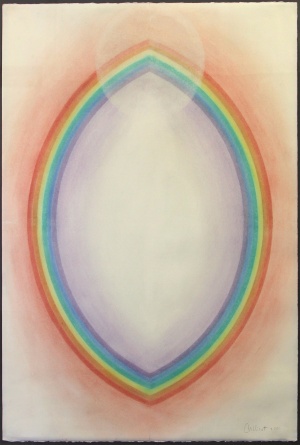Mandorla (art work): Difference between revisions
No edit summary |
No edit summary |
||
| Line 3: | Line 3: | ||
''Mandorla'' is a pastel created by [[Burton Callicott]], a member of the Memphis Lodge of the [[Theosophical Society in America]]. It hangs outside the Meditation Room in the [[L. W. Rogers Building]], the headquarters of the TSA in Wheaton, Illinois. The exhibit sign states, "Represents the human aura as an almond-shaped rainbow of the seven human principles. At the top is the white light of atma, in the center - pure emptiness, the holy void from which all comes forth." | ''Mandorla'' is a pastel created by [[Burton Callicott]], a member of the Memphis Lodge of the [[Theosophical Society in America]]. It hangs outside the Meditation Room in the [[L. W. Rogers Building]], the headquarters of the TSA in Wheaton, Illinois. The exhibit sign states, "Represents the human aura as an almond-shaped rainbow of the seven human principles. At the top is the white light of atma, in the center - pure emptiness, the holy void from which all comes forth." | ||
The artist donated the work in the year 2000, when he was 93 years old, along with another work, [[ | The artist donated the work in the year 2000, when he was 93 years old, along with another work, [[Antahkarana (art work)|''Antahkarana'']]. Callicott experimented with the mandorla form for many years. His family donated an oil version, [[Mandorla No. 12 (art work)|''Mandorla No. 12'' ]], painted in 1989. The dimensions of the pastel are 18.5 x 26 inches, or 47 x 66 cm. | ||
The [[mandorla]] is a symbol in many cultures and religions, and the name derives from the Italian word for almond. | The [[mandorla]] is a symbol in many cultures and religions, and the name derives from the Italian word for almond. | ||
Revision as of 18:10, 5 July 2012
Mandorla is a pastel created by Burton Callicott, a member of the Memphis Lodge of the Theosophical Society in America. It hangs outside the Meditation Room in the L. W. Rogers Building, the headquarters of the TSA in Wheaton, Illinois. The exhibit sign states, "Represents the human aura as an almond-shaped rainbow of the seven human principles. At the top is the white light of atma, in the center - pure emptiness, the holy void from which all comes forth."
The artist donated the work in the year 2000, when he was 93 years old, along with another work, Antahkarana. Callicott experimented with the mandorla form for many years. His family donated an oil version, Mandorla No. 12 , painted in 1989. The dimensions of the pastel are 18.5 x 26 inches, or 47 x 66 cm.
The mandorla is a symbol in many cultures and religions, and the name derives from the Italian word for almond.
